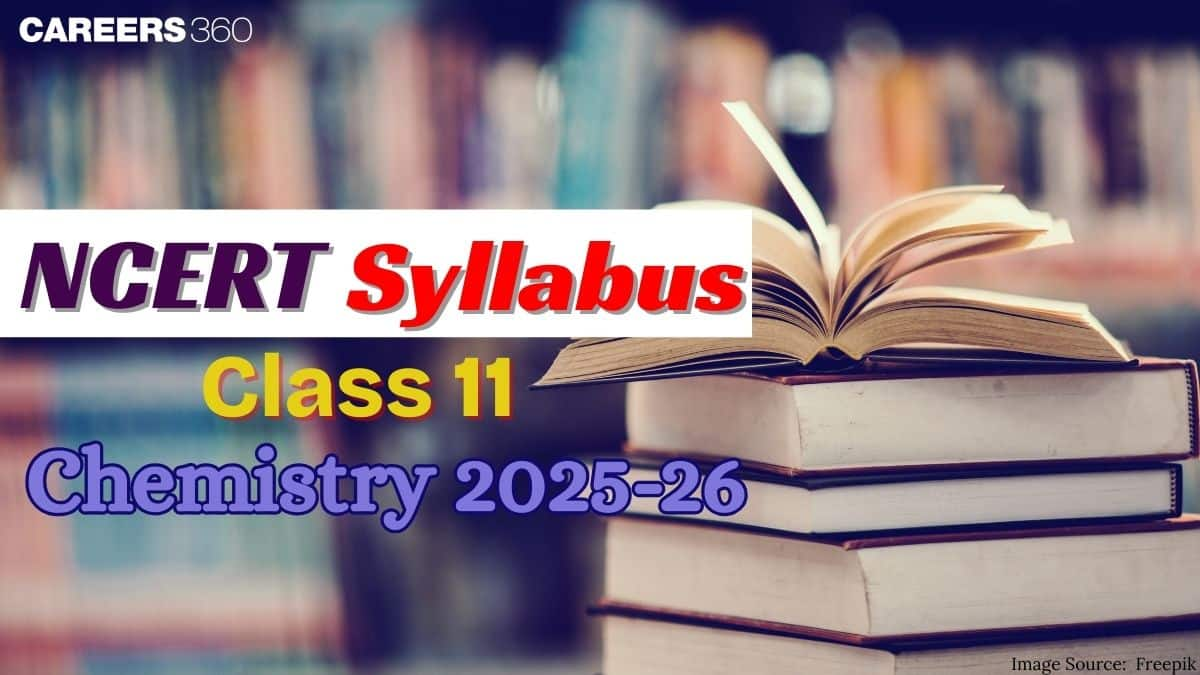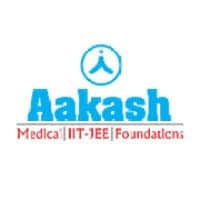Aakash Repeater Courses
ApplyTake Aakash iACST and get instant scholarship on coaching programs.
Did you know why noble gases are used in bulbs and signs, how antacids help to neutralise stomach acids and what makes water boil faster at higher altitudes than at sea level? The answer to all these questions lies in NCERT Syllabus for Class 11 Chemistry 2025-26. This syllabus introduces students to the world of atoms, molecules, and chemical reactions. The Class 11 Chemistry syllabus of 2025–26, is designed for students to prepare for advanced studies while encouraging analytical thinking, practical skills, and scientific curiosity.

Class 11 Chemistry syllabus NCERT 2025 helps students to understand key concepts in detail. NCERT Class 11 Syllabus of Chemistry introduces students to topics like Thermodynamics, Equilibrium, Chemical bonding and molecular structure, and the basics of organic chemistry. Most of the major topics of physical, organic, and inorganic chemistry are covered in the NCERT Class 11 Chemistry syllabus. This NCERT syllabus will support students for CBSE board exams as well as for competitive exams like JEE and NEET. Scroll down to download the PDF of the NCERT Syllabus for Class 11 Chemistry 2025-26.
The Class 11 Chemistry syllabus 2025-26 NCERT is designed to build a strong foundation in the subject by covering essential concepts of Physical, Organic, and Inorganic Chemistry. The NCERT Class 11 Chemistry syllabus not only helps in board exams but also aligns with competitive exams syllabus like JEE and NEET. Here are chapter-wise breakdown of NCERT class 11 chemistry syllabus:
Chapter 1: Some Basic Concepts of Chemistry
Some Basic Concepts of Chemistry is an important chapter and forms the foundation of the NCERT Syllabus for Class 11 Chemistry 2025-26. Important Laws, theories, and concepts are well discussed here.
Topics covered in Chapter 1 are given below:
1.1 Importance of Chemistry
1.2 Nature of Matter
1.3 Properties of Matter and their Measurement
1.4 Uncertainty in Measurement
1.5 Laws of Chemical Combinations
1.6 Dalton’s Atomic Theory
1.7 Atomic and Molecular Masses
1.8 Mole Concept and Molar Masses
1.9 Percentage Composition
1.10 Stoichiometry and Stoichiometric Calculations
Chapter 2: Structure of Atom
Chapter 2 Structure of Atom from Class 11 Chemistry syllabus NCERT 2025 takes you into the fascinating world of atomic models, explaining how scientists uncovered the internal structure of atoms over time.
Topics covered in Chapter 2 are given below:
2.1 Discovery of Sub-atomic Particles
2.2 Atomic Models
2.3 Developments Leading to Bohr’s Model of the Atom
2.4 Bohr’s Model for Hydrogen Atom
2.5 Towards a Quantum Mechanical Model of the Atom
2.6 Quantum Mechanical Model of an Atom
Chapter 3: Classification of Elements and Periodicity in Properties
Chapter 3 Classification of Elements and Periodicity in Properties from Class 11 Chemistry syllabus 2025-26 NCERT explores how elements are organised in the periodic table based on their atomic numbers and properties.
3.1 Why Do We need to Classify Elements?
3.2 Genesis of Periodic Classification
3.3 Modern Periodic Law and the Present Form of the Periodic Table
3.4 Nomenclature of Elements with Atomic Numbers > 100
3.5 Electronic Configurations of Elements and the Periodic Table
3.6 Electronic Configurations and Types of Elements: s-, p-, d-, f- Blocks
3.7 Periodic Trends in Properties of Elements
Chapter 4: Chemical Bonding and Molecular Structure
Chapter 4 Chemical Bonding and Molecular Structure of NCERT Class 11 Chemistry syllabus explains how atoms combine to form molecules through different types of chemical bonds like ionic, covalent, and coordinate bonds.
Topics covered in Chapter 4 are given below:
4.1 Kössel-Lewis Approach to Chemical Bonding
4.2 Ionic or Electrovalent Bond
4.3 Bond Parameters
4.4 The Valence Shell Electron Pair Repulsion (VSEPR) Theory
4.5 Valence Bond Theory
4.6 Hybridisation
4.7 Molecular Orbital Theory
4.8 Bonding in Some Homonuclear Diatomic Molecules
4.9 Hydrogen Bonding
Chapter 5: Thermodynamics
Thermodynamics, a key topic in the NCERT Class 11 Chemistry syllabus, deals with the study of energy changes during chemical and physical processes. This fundamental concept is thoroughly explained in the textbook and is an important part of the NCERT Syllabus PDF for Class 11 Chemistry.
Topics covered in Chapter 5 are given below:
5.1 Thermodynamic Terms
5.2 Applications
5.3 Measurement of ∆U and ∆H: Calorimetry
5.4 Enthalpy Change, ∆rH of a Reaction – Reaction Enthalpy
5.5 Enthalpies for Different Types of Reactions
5.6 Spontaneity
5.7 Gibbs Energy Change and Equilibrium
Chapter 6: Equilibrium
Equilibirium is an important chapter in the Class 11 Chemistry syllabus 2025-26 NCERT, explores the dynamic balance between the forward and reverse reactions in both physical and chemical processes.
Topics covered in Chapter 6 are given below:
6.1 Equilibrium in Physical Processes
6.2 Equilibrium in Chemical Processes – Dynamic Equilibrium
6.3 Law of Chemical Equilibrium and Equilibrium Constant
6.4 Homogeneous Equilibria
6.5 Heterogeneous Equilibria
6.6 Applications of Equilibrium Constants
6.7 Relationship between Equilibrium Constant K, Reaction Quotient Q and Gibbs Energy G
6.8 Factors Affecting Equilibria
6.9 Ionic Equilibrium in Solution
6.10 Acids, Bases, and Salts
6.11 Ionization of Acids and Bases
6.12 Buffer Solutions
6.13 Solubility Equilibria of Sparingly Soluble Salts
Chapter 7: Redox Reaction
Redox reaction of Class 11 Chemistry syllabus 2025-26 NCERT focuses on chemical reactions involving the transfer of electrons, highlighting the concepts of oxidation and reduction
Topics covered in Chapter 7 are given below
7.1 Classical Idea of Redox Reactions - Oxidation and Reduction Reactions
7.2 Redox Reactions in Terms of Electron Transfer Reactions
7.3 Oxidation Number
7.4 Redox Reactions and Electrode Processes
Chapter 8: Organic Chemistry – Some Basic Principles and Techniques
Some Basic Principles and Techniques of NCERT Class 11 Chemistry syllabus lays the foundation for understanding the structure, bonding, and classification of organic compounds.
Topics covered in Chapter 7 are given belo
8.1 General Introduction
8.2 Tetravalence of Carbon: Shapes of Organic Compounds
8.3 Structural Representations of Organic Compounds
8.4 Classification of Organic Compounds
8.5 Nomenclature of Organic Compounds
8.6 Isomerism
8.7 Fundamental Concepts in Organic Reaction Mechanism 8.8 Methods of Purification of Organic Compounds
8.9 Qualitative Analysis of Organic Compounds
8.10 Quantitative Analysis
Chapter 9: Hydrocarbons
The chapter Hydrocarbons of NCERT Syllabus for Class 11 Chemistry 2025-26 deals with the study of compounds made up of hydrogen and carbon, including alkanes, alkenes, alkynes, and aromatic hydrocarbons.
Topics covered in Chapter 9 are given below
9.1 Classification
9.2 Alkanes
9.3 Alkenes
9.4 Alkynes
9.5 Aromatic Hydrocarbon
9.6 Carcinogenicity and Toxicity
The NCERT Syllabus for Class 11 Chemistry Practical Examination is designed to enhance students understanding of theoretical concepts through hands-on laboratory experience.
| Evaluation Scheme for Examination | Marks |
| Volumetric Analysis | 8 |
| Salt Analysis | 8 |
| Content Based Experiments | 6 |
| Project Work | 4 |
| Class record and Viva | 4 |
| Total | 30 |
A. Basic Laboratory Techniques
Cutting glass tube and glass rod
Bending a glass tube
Drawing out a glass jet
Boring a cork
B. Characterization and Purification of Chemical Substances
Determination of melting point of an organic compound.
Determination of boiling point of an organic compound.
Crystallization of impure sample of any one of the following: Alum, Copper Sulphate, Benzoic Acid.
C. Experiments based on pH
1.Any one of the following experiments:
Determination of pH of some solutions obtained from fruit juices, solution of known and varied concentrations of acids, bases and salts using pH paper or universal indicator.
Comparing the pH of solutions of strong and weak acids of same concentration.
2. Study the pH change by common-ion in case of weak acids and weak bases.
D. Chemical Equilibrium
Any one
Study the shift in equilibrium between ferric ions and thiocyanate ions by increasing/decreasing the concentration of either of the ions.
Study the shift in equilibrium between
E. Quantitative Estimation
Using a mechanical balance/electronic balance.
Preparation of standard solution of Oxalic acid.
Determination of strength of a given solution of Sodium hydroxide by titrating it against standard solution of Oxalic acid.
Preparation of standard solution of Sodium carbonate.
Determination of strength of a given solution of hydrochloric acid by titrating it against standard Sodium Carbonate solution.
F. Qualitative Analysis
1. Determination of one anion and one cation in a given salt
Cation:
Pb²⁺, Cu²⁺, As³⁺, Al³⁺, Fe³⁺, Mn²⁺, Zn²⁺, Ni²⁺, Ca²⁺, Sr²⁺, Ba²⁺, Mg²⁺, NH₄⁺
Anions:
(CO₃)²⁻, S²⁻, (SO₃)²⁻, (NO₂)⁻, (SO₄)²⁻, Cl⁻, Br⁻, I⁻, (PO₄)³⁻, (C₂O₄)²⁻, CH₃COO⁻, NO₃⁻
(Note: Insoluble salts excluded)
2. Detection of -Nitrogen, Sulphur, Chlorine in organic compounds.
G. Projects
Scientific investigations involving laboratory testing and collecting information from other sources
A few suggested Projects
• Checking the bacterial contamination in drinking water by testing sulphide ion
• Study of the methods of purification of water
• Testing the hardness, presence of Iron, Fluoride, Chloride, etc., depending upon the regional variation in drinking water and study of causes of presence of these ions above permissible limit (if any).
Students can download the NCERT Syllabus for Class 11 Chemistry 2025-26 from the official NCERT website. Having the updated NCERT Syllabus PDF will help you to prepare well for exams.
Step 1: Go to the official NCERT website at http://ncert.nic.in.
Step 2: On the home page, in the 'Search' option and type 'Syllabus' and click on it. This will take you to the syllabus page.
Step 3: Click on the 'Syllabus for secondary and higher secondary classes' option. The syllabus PDF will open.
Step 4: Choose the "Chemistry (XI- XII)" in the PDF.
Step 5: The NCERT Class 11 chemistry syllabus PDF will be displayed on your screen. Download and save it for future use.
Note*: The Class 11 chemistry latest syllabus is not updated on the NCERT official website. Students can download the latest NCERT Class 11 chemistry syllabus from this page, which is given below.
Given below some of the best reference books for Chemistry that complement the NCERT Syllabus for Class 11 Chemistry 2025-26:
1. NCERT Chemistry textbook
2. Pradeep new course chemistry
3. Physical chemistry by O.P. Tondon
4. Dinesh Chemistry
They are helpful guide to students that will help them build a deeper understanding of the topics covered. The language is simple and engaging.
| Overview | Details |
| Board Name: | Central Board of Secondary Education |
| Total Marks: | 100 |
| Theory Marks: | 70 |
| Project Marks: | 30 |
| Exam Duration: | 3 Hours |
| Total Sections: | 2 Sections (Theory & Internal) |
The marks distribution for NCERT class 11 chemistry is segregated into theory (70 marks) and practical (30 marks).
The theory paper is divided into short answers, long answers, and numerical questions.
The practical is about answering viva questions and practical chemistry tests in a laboratory.
Follow the links below to get your hands on the syllabus available for other subjects. Get them to get a clear idea.
The links provided in the table below will give you access to the books prescribed for Class 11.
Yes, it is necessary to study the NCERT syllabus for Class 11 Chemistry for board exams, as the question paper is based on the NCERT syllabus.
The NCERT syllabus for Class 11 Chemistry can be found on the official NCERT website or in the NCERT textbook for Class 11 Chemistry.
The time spent studying each chapter in the NCERT syllabus for Class 11 Chemistry may vary depending on the difficulty level of the chapter and your understanding of the topic. However, it is recommended to spend at least one week on each chapter.
No, there is no change in the NCERT Chemistry class 11 syllabus.
To prepare effectively for the Class 11 Chemistry board exams based on the NCERT syllabus, it is recommended to read the textbook thoroughly, make notes, revise regularly, practice problems and sample papers, and clarify doubts with teachers or peers.
There are a total of 9 chapters in the NCERT class 11 chemistry
Application Date:24 July,2025 - 23 August,2025
Application Date:24 July,2025 - 23 August,2025
Late Fee Application Date:06 August,2025 - 10 August,2025
Late Fee Application Date:06 August,2025 - 10 August,2025

Take Aakash iACST and get instant scholarship on coaching programs.

This ebook serves as a valuable study guide for NEET 2025 exam.

This e-book offers NEET PYQ and serves as an indispensable NEET study material.

As per latest syllabus. Physics formulas, equations, & laws of class 11 & 12th chapters
As per latest syllabus. Chemistry formulas, equations, & laws of class 11 & 12th chapters
As per latest 2024 syllabus. Study 40% syllabus and score upto 100% marks in JEE